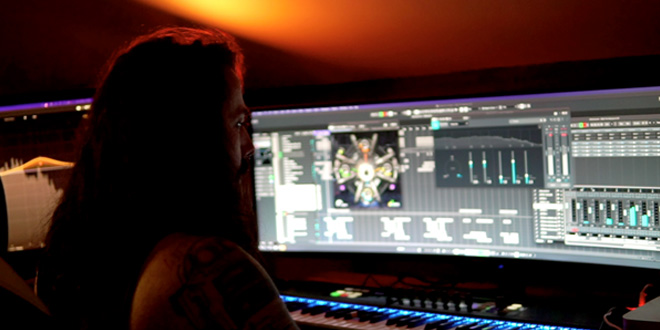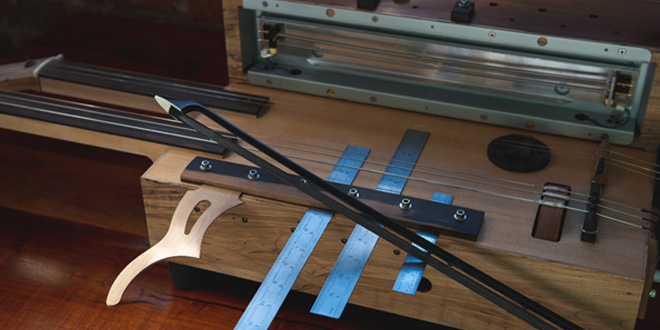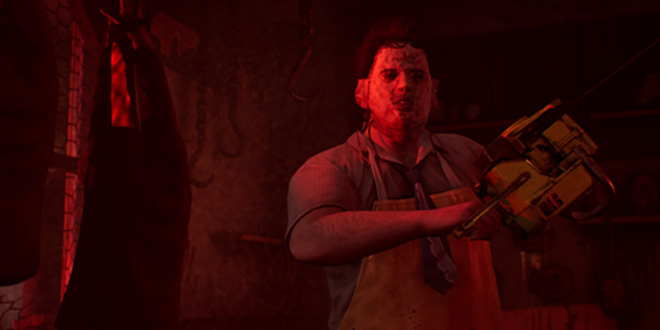 by Ellie Greenfield, junior PR and comms manager at Sumo Group
by Ellie Greenfield, junior PR and comms manager at Sumo Group
As candles across the land begin to fill the air with the scent of pumpkin spice and the dark nights come rolling in, it’s the perfect time to shut the curtains, cosy up… and play terrifying games to scare ourselves silly, obviously!
One fright-fan who is thriving this time of year is BAFTA-nominated audio director and composer at Sumo Nottingham, Ross Tregenza. Most recently, Ross has been immersed in a world of horror, obscure instruments and wicked weapons as part of the team behind The Texas Chain Saw Massacre and has been able to combine two of his greatest loves: scary movies and weird noises.
Here, Ross takes us through his journey of experimentation to create a soundtrack full of Texan tension and a soundscape to frighten even the most seasoned horror lovers, and spills his guts about frightening players through audio in games.
“After three years of blood, sweat and chain saws, The Texas Chain Saw Massacre – an asymmetrical multiplayer horror game based on the iconic 1974 movie of the same name — was released to the world in August of this year,” says Tregenza. “Lovingly created by our team at Sumo Nottingham and its publishing partners Gun Interactive, The Texas Chain Saw Massacre transports players to the spring of 1973 where they can take on the roles of the notorious Slaughter Family out for blood, or as a potential victim desperate to escape.

“We had so many things to consider when making this game. The vision for the project all aligned back to a common goal — it had to feel like the movie. To us, this meant two things. Firstly: it had to be authentic, if there was something you could see in the movie, you had to be able to step into and explore it in the game. Second: it had to carry the same harrowing feeling of tension and dread for the audience.
“I’ve loved the movies for years. I’m a huge horror fan, so the opportunity to really get under the skin of this one was an incredibly exciting prospect. Turns out, you never really know just how into horror movies you are until you watch one hundreds, and hundreds… and hundreds of times…”
THE MUSIC OF THE NIGHT (AND THE OTHER TIMES OF DAY YOU CAN PLAY THE GAME)
“While the game was in its infancy and the team were identifying what the gameplay would look and feel like, I got to work composing the music. The soundtrack for the original movie blurred the line between music and sound design, and the real and abstract, and composer Wayne Bell drew on a genre called ‘Musique Concréte’ — which is the idea that there’s no adherence to traditional instruments or rhythm and is instead just a wild soundscape of sounds woven together.

“I knew that to do justice to the original score, I would need to use a collection of weird and wonderful instruments to create a truly horrific soundscape,” continues Tregenza. “This journey began when the CEO of Gun Interactive, Wes Keltner, commissioned the build of a special instrument called the Apprehension Engine — which had previously been used to terrifying effect by composer Mark Korven in movies like The Witch and The Lighthouse. This bizarre piece of equipment is best known for inspiring fear in the listener, and we found that using it in different ways provided us with scrapes, moans, vicious slams and much more… I couldn’t wait to get started!”

“… Unfortunately, this was back in 2020 so getting my hands on this piece of kit residing in Gun’s HQ in Kentucky USA, wasn’t exactly easy,” muses Tregenza. “Luckily for me, Wes is a musician in his own right, so he was able to use the Apprehension Engine frighteningly well to record a bank of sounds for me to play with which acted as my jumping off point for every single track you can hear on the Texas soundtrack.
SPONTANEOUS INSTRUMENTS OF EVIL
“I then went on a shopping spree of my own to acquire all kinds of weird, wild and wonderful instruments from all over the world – including the Scary Crown (an instrument that looks like a torture device and sounds like the gates of hell opening), a Soma Lyra (a touch sensitive drone that converts human touch into mournful wailing) and my custom modular synthesiser I affectionately call ‘The Beast’ — for which I collected parts throughout development, and can be fed a variety of sounds and it will generate hours of soundscape for me to hunt the best bits. It’s wonderfully chaotic and definitely has a mind of its own! I recorded all of this in my home studio and can neither confirm nor deny if I didn’t get some VERY startled looks from my neighbours when taking my bin out …” laughs Tregenza.
“All of these incredible instruments were then layered, mixed and peppered with sound design elements to really push the tension, and I spent much of my time running the sounds of squealing pigs and human screams through modular synthesizers and contorting them into new shapes and sounds, with just enough of the original source left to generate primal fear in the player. I added distortion, echo and even the use of a 1970s reel-to-reel simulation to mould it into the right language for the game.

“I wanted to emulate the same ‘all of nothing’ feeling that the movie’s soundtrack had, which would swerve wildly between silence and extreme noise, and approached the flow of the music almost as an X/Y axis of content – with X being rising tension throughout a match, and Y being momentary flares of music. This allowed me to create a dynamic audio system which would respond to the actions of the player — it’s a living, breathing character in our game.
“As such, you’ll notice that the music you hear when playing differs from the game’s soundtrack which is instead montages of audio layers found in the game’s dynamic music system which form infinite combinations of up to 10 tracks playing at once. No two sessions of The Texas Chain Saw Massacre will ever sound the game, removing any sense of familiarity of comfort as a player.

“Inflicting fear is a fine balancing act and finding the right moments to go big, when to provide momentary relief, when to cause dread, and when to evolve the levels to absolute terror,” explains Tregenza. “A lot of horror movies will use the soundtrack to signpost upcoming moments of terror to provide the viewer with a warning, but my favourite horror movies are the ones that turn this on its head. A great example is Colin Stetson’s fantastic score for Hereditary, which often has long passages of rising tension in the soundtrack that don’t relate to the onscreen events at all, which leaves you feeling really discombobulated and tense, and in Texas there is no single song that plays when you’re in imminent danger so you’re always listening for smaller, audible clues.
“Similarly, some of the most brutal scenes of violence in movies are the ones delivered with a controlled minimalism — think No Country for Old Men or Killing Them Softly — the simplicity and calm framing lends so much extra gravitas. Therefore, I wanted to deliver kills in The Texas Chain Saw Massacre without bombastic music or over the top sound design, and instead muted the music and muffled everything happening around the event — leaving only the sounds of the two characters engaged in the horrific act.”
RIP, ROARING AND REVVING – THE CHAIN SAW
“The team over at Gun Interactive are huge horror fans and, especially when it comes to an IP so beloved as The Texas Chain Saw Massacre, are willing to go to extreme lengths to get it right. As such, nailing the sound of one of the most iconic weapons in cinematic history was a must,” says Tregenza.
“The chain saw in the movie has a very distinct sound profile, and no ‘off the shelf’ chain saw would suffice. Gun managed to secure the exact make, model and year of the saw from the movie (a modified Poulan 245a) and worked with engineers to get it restored and running. From there, they worked with legendary field recordist Watson Wu to capture this magnificent machine in all its glory and provide me with a huge series of recordings to work with.

“When it came to utilising the chain saw in-game, it was important to everyone working on the project that you could never quite escape this titular weapon — whether that was the hum of it in the distance, or the roar of Leatherface’s incoming attack,” explains Tregenza.
“This served us in a couple of ways: from a gameplay POV, Victims were given a deafening warning that Leatherface was near and given a chance to escape, and it really supported our vision of the game feeling relentless — like something is always pursuing the player. This technique of having an ever-present ‘villain’ was used to great effect in Resident Evil 2, with its terrifying antagonist Mr. X being almost always audible regardless of distance to make him feel truly inescapable. Our team has played The Texas Chain Saw Massacre thousands of times, but even now the mighty roar of the chain saw still gives us goosebumps.”
THE SOUND OF FLESH
“As the game continued to develop over the next couple of years, I worked in parallel with the teams at both Sumo Nottingham and Gun to create a complimentary soundscape, and I relished the opportunity to understand the nuances of creating fear and tension through sound. The movie is a rollercoaster of relentless terror that grabbed audiences and never let them catch their breath throughout its less than 90-minute run time… and this is what we wanted to replicate in the game,” says Tregenza, enthusiastically.
“When you start working on sound design for an interactive piece of media like a game, the biggest challenge is to establish an easy-to-understand audio language for players which can best support their gameplay… and that is made much harder when you’re looking to build a soundscape packed with abstract sounds. For Texas Chain Saw, it came down to establishing the extremes — the important sounds that mean an event is happening or something is nearby, versus the trivial — and keeping the tone and texture of the sound consistent.”

“I wanted to create a sound that would immediately alert players that something important was happening,” continues Tregenza. “In the movie, you can hear an iconic sound similar to a camera flash bulb at crucial moments, and I wanted to create a spectrum of sounds based on this to convey the severity of a situation – gotten close to a family member? The feedback from that sound can be heard. Been spotted by a Family Member? That sound will be played in full… and you better run! Creating an auditory language means the player can immediately understand what is happening and how to react.”
“Players of The Texas Chain Saw Massacre can find themselves in one of three maps – the Family House, the Gas Station or the Slaughter House. These environments provide huge opportunity for players to perfect their skills in stealth through their use of shadows, crawl spaces and hiding places… but they also contribute to its eerie atmosphere. Ross continued: “Environmental sound was always going to be absolutely key to establishing tension in this game… and we went deep! In the original movie, the Family House was as much of a character as any of the cast, packed with gruesome mementos of the family’s crimes and layered with dirt, clutter and grime.
“That layering played a huge role in my approach, and I went through countless cycles of using a sound as a starting point, and adding in more debris, creaking wood, groaning metal and blustery wind – piling it all on top of each other with an organic haphazardry. The result is a world that feels like it’s crawling with malignant energy that players can never quite shake.”

Of course, Tregenza took inspiration from other spooky sources as well.
“As a huge horror fan, I took a deep dive into an endless catalogue of horror movies and games for inspiration and both Alien Isolation and The Descent provided me with a want to fill the game with ‘false positives’. In both of these examples, long before the scary creatures make their true appearance, shadows and the sound of movement would jolt the viewer into thinking it was nearby. In our game, I recreated this effect and upped the ante — creaking metal to sound like the chain saw engine, wind in the tunnels mimicking the human breath, and debris falling from the ceiling to sound like approaching footsteps. This deliberate deception means the player has to stay alert at all times to try and conclude if their mind is playing tricks on them, or if danger truly is right around the corner…”
“Working on The Texas Chain Saw Massacre has been the wildest, most experimental and incredible experience of my career. I got to work with an IP that is so beloved, get my hands on some really interesting kit and, of course, terrify players. So, as you’re settling down to watch your favourite horror movie or picking up your scariest game this Halloween season, be sure to pay attention to the soundscape around you and prepare to be very, very afraid…”

 MCV/DEVELOP News, events, research and jobs from the games industry
MCV/DEVELOP News, events, research and jobs from the games industry




